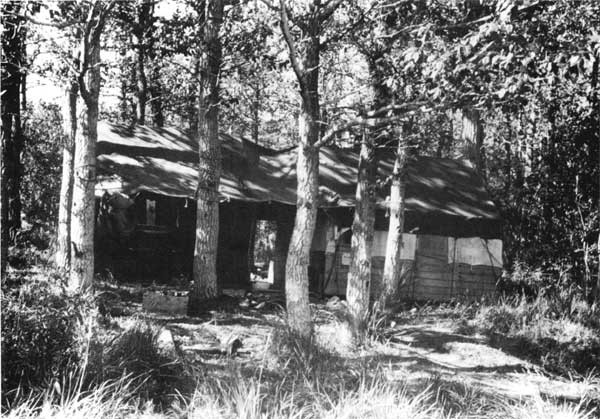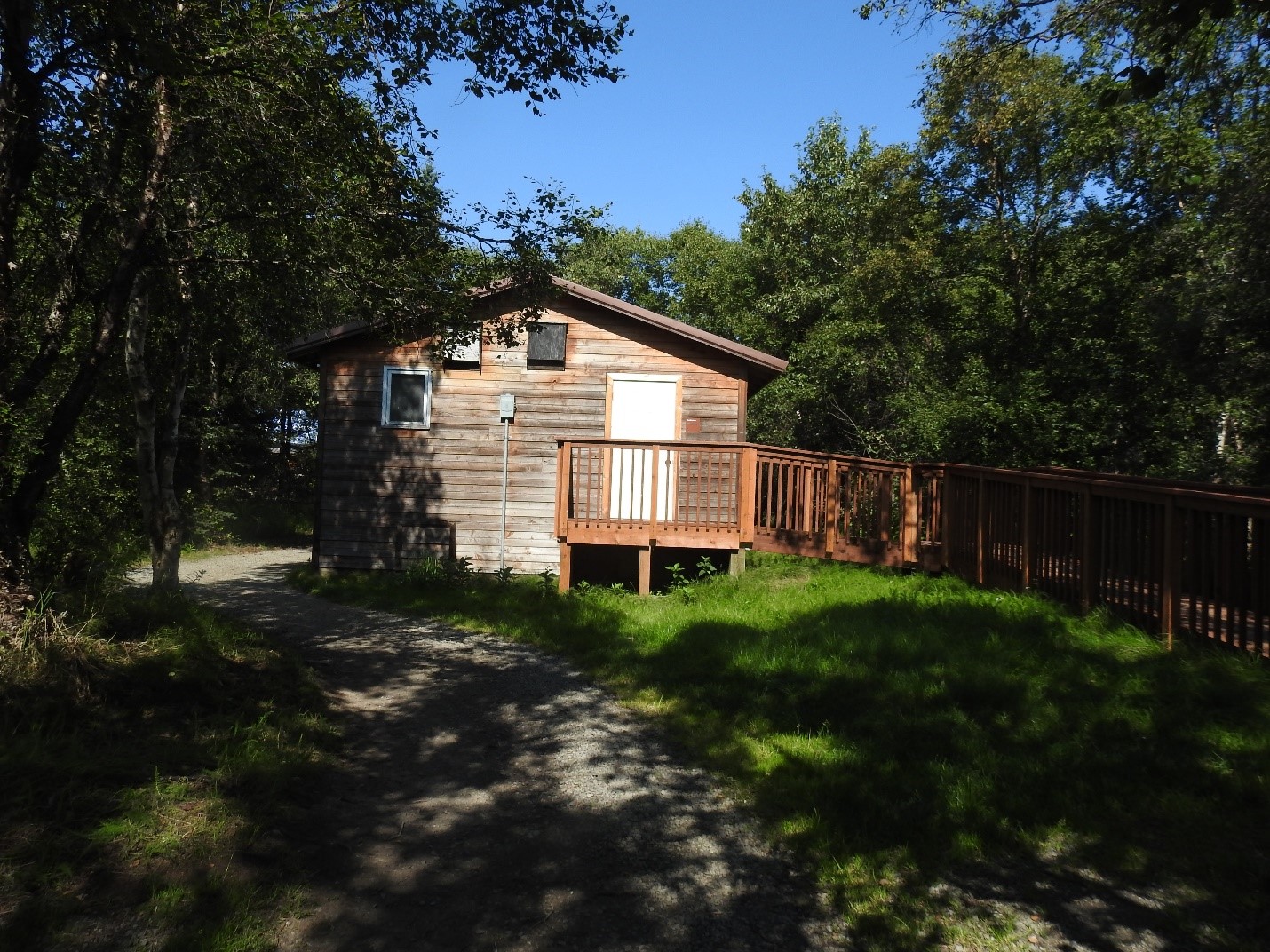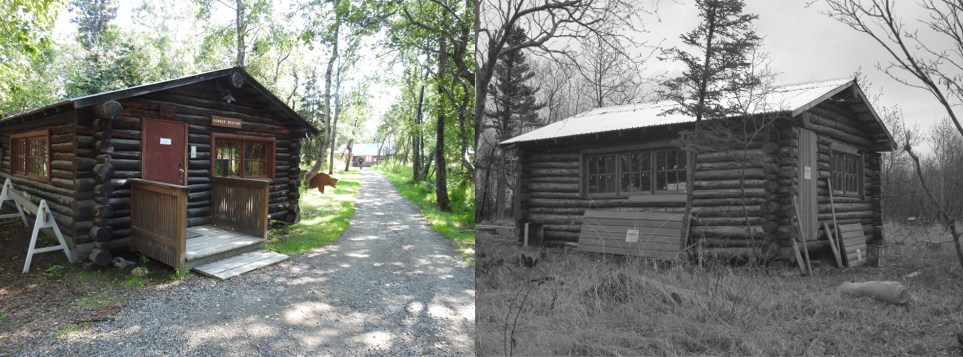August brings quiet to Brooks Camp as the bears wander off and the visitors arrive less frequently. The quiet is especially noticeable during the day when everyone is on the bridge or at the Falls. Walking through the campground, we can see all different styles and colors of tents spread out among the trees. Located right off the beach from Naknek Lake, it is an idyllic location for camping. It is here that the first Katmai ranger chose to build the ranger station in 1950. While the original station was a tent cabin, the station has since been moved twice, both times to wooden, more permanent structures.
 First NPS Ranger Station in Brooks Camp, 1950. NPS Photo
First NPS Ranger Station in Brooks Camp, 1950. NPS PhotoHere at Brooks Camp, we have been repurposing our buildings for years. It is easy to recognize the older structures in camp, many have been here since the early 60s and feature the same rustic design. Many have been renovated several times, allowing us to reuse resources instead of discarding them. Supplies are difficult to find and expensive to transport to the area, so modifying the existing structures just makes more sense.
For example, when in 1974 contractors were hired to complete a utility renovation in Brooks Camp, they constructed a large bunkhouse for their workers. Once their work was complete, NPS managed to convert the bunkhouse into Brooks’ first Visitor’s Center/auditorium. Now the rangers finally had a place to greet visitors and present evening programs. The building was used in this capacity from 1977-1989, when a larger Visitor’s Center was needed. Today, it continues to host the rangers’ nightly evening presentations.
 Auditorium 1977 – present, NPS Photo/ C Kliesrath
Auditorium 1977 – present, NPS Photo/ C KliesrathVisitation increased steadily, and it became clear that fishing was not the only attraction at Brooks Camp. The bears and salmon were bringing thousands of visitors, increasing the needs for visitor services and interpretation. While the auditorium was appropriate as of the rangers’ evening programs, it became clear that there was a need for more space and a separate visitors’ center.
Some may recognize this building where you may have received your bear orientation or even checked in with a ranger for the campground. Originally a ranger station built in 1956, modifications were made, keeping with its original design, and a small addition was added to the back of the cabin. This was the first permanent NPS station in the park. Completed in 1990, this became our current Visitors’ Center and bear orientation room.

(Left) Visitor Center 1991 – present. NPS Photo (Right) First hard-sided ranger station 1950-1990. NPS Photo
Down the trail stood a structure that was originally a boathouse built in 1960 of the same size and style as the original hard sided ranger station. Originally it had served as a boathouse, then a VIP cabin, and for a time, even a space for interpretive ranger presentations. Conveniently located near the new visitors’ center, it seemed the perfect place to relocate the ranger station. Today, it is office space where you can find the rangers taking care of their day-to-day tasks, such as checking their email or planning camp activities. The bear cutout located just to the side of the log cabin demonstrates 50 yards from the Visitor’s Center, one of the first rules you learn about required distancing from the bears.
 (Left) Ranger Station 1991-present. NPS Photo/ C Kliesrath (Right) Boathouse 1962-1990. NPS Photo
(Left) Ranger Station 1991-present. NPS Photo/ C Kliesrath (Right) Boathouse 1962-1990. NPS PhotoLocated just outside the Brooks Camp area, this building on Lake Brooks served as the Lake Brooks National Marine Research Station. Original construction was completed in 1943 and expanded in 1957 to include the wings on either side of the main building. Designed for the Fish and Wildlife Service to study salmon and other fish in the area, it would serve as one of the major Bristol Bay-area fisheries research headquarters for over 30 years. No longer needed it was acquired by the National Park Service in 1979 and is currently used for employee housing for seasonal employees.
 NPS employee housing, formerly National Marine Research Station. NPS Photo
NPS employee housing, formerly National Marine Research Station. NPS PhotoMany of our other current buildings in camp are the original structures, still used today as employee housing, generator buildings, recreation centers, and bath and laundry facilities. Since Brooks is so remote, it is essential that the buildings are versatile and can be easily adapted to fit the needs of the camp. Naturally, it helps that Brooks Camp is nestled in amongst the spruce, cottonwoods, and willows, making it the perfect place to enjoy Katmai, especially the scenery, the fishing, and of course the bears!
Walking through Brooks Camp today, it appears that little has changed since many of these buildings were constructed in the 1960s. It is interesting to speculate what changes may occur in the years to come. The Brooks River area is both a National Historic Landmark (NHL) and on the National Register of Historic places. It is considered one of the top five historical places in the state of Alaska, making it essential to preserve the overall feel and look of the area as we update or repurpose its buildings.
